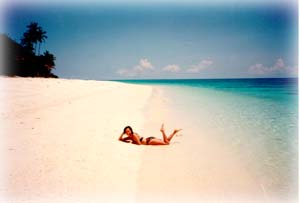

|
Hold it! I know what you're thinking: "OK, OK, we see the Beach. So where's ..." I'm warning you that my web page gets violent when you say bad words. |
|
( By the way, due to my artistic photographer/director's insistent demand, here's his
picture
|
Now you're guessing where this pristine beach is. Hawaii? The Bahamas? Well, it's halfway around the world: in the island of Boracay in the Philippines!
 |
"The Pearl of the Orient" |
The Philippines is an archipelago (that means "cluster of islands") in Southeast Asia. When one Filipino contestant was asked at an international beauty pageant how many islands there are, she asked back, "High tide or low tide?" We actually have at least 7,000 islands and I guess some are "Now you see it, now you don't." But the main islands are Luzon (where Manila, the capital, is), Visayas (where Boracay is), and Mindanao.
It was discovered in 1521 by a Portuguese named Magellan who was under the Spanish banner. The islands were then named after King Philip II of Spain. The Spaniards brought Catholicism and stayed for three centuries. Hence, our language, Filipino (based on the main dialect, Tagalog) has a lot of Spanish words (which underwent subtle changes in pronunciation and spelling).
Our language is also based on Malay so things really get interesting. One nice thing, though, is that it's easy to read and spell in Tagalog. It's basically spelled the way it sounds, period.
The Philippines also became an American colony for a couple of years before it finally gained its independence on June 12, 1896. The Americans were the ones who gave us the gift of education. Ever since, the Filipinos have always been fond of anything and anyone American (generally- speaking). American English is the second language which is widely used especially in the business community. Almost all signs (road, advertising, etc.) and even the major dailies are in English. Students learn English from kindergarten through early college.
Shopping in Metro Manila is a blast (especially when you're a dollar earner). Malls are huge as in HUGE which really is ironic considering the economic situation in the country. They open at 10am and close at about 8pm. Salesclerks can speak and understand English, of course, unless your accent's "strange": An Aussie acquaintance of mine told me how much he and his wife enjoyed shopping in Manila. In one shop where the latter was buying a pair of shoes, she kept asking for "Size Ite" ("ite" as in "bite") and the poor saleslady just stared at her blankly until she (the wife) realized what the problem was and said "Size Eight", the American way.
Now let me tell you about real Filipino retail-shopping. "Sari-sari" (literally means "miscellaneous") stores are everywhere in the neighborhood (except in the high-class ones). You'll say, "Big deal. It's another 7-11, right?" Can you buy A STICK of cigarette at 7-11? Or HALF a cup of vinegar (with you bringing your own cup)? If you're an American used to big servings and bulk sales, you'll wonder at this absurdity. This practice stemmed from the fact that most lower-class citizens don't have enough money to buy the "full quantity".
Traveling can be expensive because of the obvious reason that the Philippines is scattered on the Pacific Ocean. The beaches are awesome the farther they are from Manila. Getting around Metro Manila is a nightmare because of the horrendous traffic and pollution.
Here are some nice places to go to in Metro Manila and the surrounding provinces:
![]() Villa Escudero
Villa Escudero
![]() Hidden Valley
Hidden Valley
![]() Nature Church
- Moonwalk Subd in Las Pinas
Nature Church
- Moonwalk Subd in Las Pinas
![]() Paniman Beach - (Puerto Azul) in Ternate, Cavite
Paniman Beach - (Puerto Azul) in Ternate, Cavite
![]() Marbella Resort
Marbella Resort
Last updated on 17Mar00
| HOME | Top | Jim | Engagement | Photo Album | Musicals | Restaurants | Sydney | Career | Philippines | Email | View Guestbook | Sign Guestbook | Disclaimer |